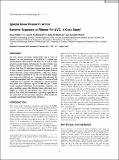Files in this item
Extreme exposure to filtered far-UVC : a case study
Item metadata
| dc.contributor.author | Eadie, Ewan | |
| dc.contributor.author | Barnard, Isla M.R. | |
| dc.contributor.author | Ibbotson, Sally H. | |
| dc.contributor.author | Wood, Kenneth | |
| dc.date.accessioned | 2021-02-22T09:30:11Z | |
| dc.date.available | 2021-02-22T09:30:11Z | |
| dc.date.issued | 2021-02-03 | |
| dc.identifier | 272465816 | |
| dc.identifier | 7691add7-e031-4920-97e5-a8af5320bbfa | |
| dc.identifier | 85100354686 | |
| dc.identifier | 000614190200001 | |
| dc.identifier.citation | Eadie , E , Barnard , I M R , Ibbotson , S H & Wood , K 2021 , ' Extreme exposure to filtered far-UVC : a case study ' , Photochemistry and Photobiology , vol. Early view . https://doi.org/10.1111/php.13385 | en |
| dc.identifier.issn | 0031-8655 | |
| dc.identifier.other | RIS: urn:C3EBADE74FECE1B3F0D3A0D91DEB73CC | |
| dc.identifier.uri | https://hdl.handle.net/10023/21468 | |
| dc.description.abstract | Far-UVC devices are being commercially sold as "safe for humans" for the inactivation of SARS-CoV-2, without supporting human safety data. We felt there was a need for rapid proof-of-concept human self-exposure, to inform future controlled research and promote informed discussion. A Fitzpatrick Skin Type II individual exposed their inner forearms to large radiant exposures from a filtered Krypton-Chloride (KrCl) far-UVC system (SafeZoneUVC, Ushio Inc., Tokyo, Japan) with peak emission at 222 nm. No visible skin changes were observed at 1,500 mJcm-2, whereas skin yellowing that appeared immediately and resolved within 24 hours occurred with a 6,000 mJcm-2 exposure. No erythema was observed at any time point with exposures up to 18,000 mJcm-2. These results combined with Monte Carlo Radiative Transfer computer modelling suggest that filtering longer ultraviolet wavelengths is critical for the human skin safety of far-UVC devices. This work also contributes to growing arguments for the exploration of exposure limit expansion, which would subsequently enable faster inactivation of viruses. | |
| dc.format.extent | 614761 | |
| dc.language.iso | eng | |
| dc.relation.ispartof | Photochemistry and Photobiology | en |
| dc.subject | RL Dermatology | en |
| dc.subject.lcc | RL | en |
| dc.title | Extreme exposure to filtered far-UVC : a case study | en |
| dc.type | Journal item | en |
| dc.contributor.institution | University of St Andrews. School of Physics and Astronomy | en |
| dc.contributor.institution | University of St Andrews. Centre for Biophotonics | en |
| dc.identifier.doi | https://doi.org/10.1111/php.13385 | |
| dc.description.status | Peer reviewed | en |
This item appears in the following Collection(s)
Items in the St Andrews Research Repository are protected by copyright, with all rights reserved, unless otherwise indicated.

